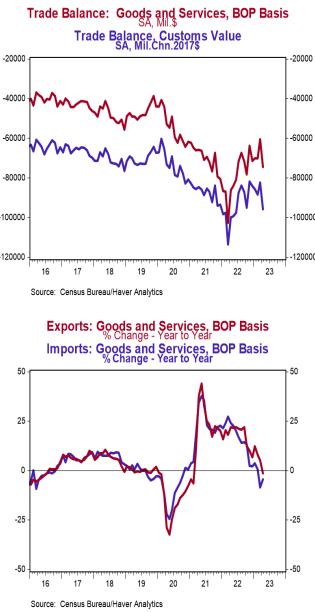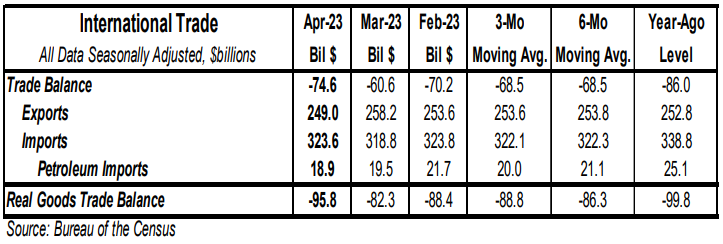- The trade deficit in goods and services came in at $74.6 billion in April, smaller than the consensus expected $75.8 billion.
- Exports declined by $9.2 billion, led by crude oil and fuel oil. Imports rose by $4.8 billion, led by cellphones & other household goods, finished metal shapes, and non-monetary gold.
- In the last year, exports are down 1.5% while imports are down 4.5%.
- Compared to a year ago, the monthly trade deficit is $11.4 billion smaller; after adjusting for inflation, the “real” trade deficit in goods is $4.0 billion smaller than a year ago. The “real” change is the trade indicator most important for measuring real GDP.
Implications: The trade deficit in goods and services rose to $74.6 billion in April as exports declined while imports grew. We like to focus on the total volume of trade, imports plus exports, as it represents the extent of business and consumer interactions across the US border. This measure fell by $4.4 billion in April, is down 3.2% versus a year ago, and is now 4.2% lower than last year's peak in June. These declines are consistent with our forecast that the US is headed toward a recession. Imports grew by $4.8 billion in April but still remain down 4.5% versus a year ago indicating weakening demand for goods domestically, as there is a continuing trend toward spending on services. It’s important to remember, too, that Russia’s invasion of Ukraine and the easing of COVID restrictions in China may affect trade patterns for some time. So far this year, imports from China are down 25.9% versus a year ago, dropping China to the third largest exporter to the US behind Mexico and Canada. The good news is that supply-chain problems have improved dramatically. Daily freight rates are also falling rapidly and back to pre-COVID levels or lower, as demand for shipping has also weakened. The New York Fed’s Global Supply Chain Pressure Index confirmed this in April, with the index staying in negative territory, -1.35 standard deviations below the index’s historical average. Weaker demand coupled with an easing of parts shortages and less shipping congestion have pulled the indicator lower. Also notable in today’s report, the dollar value of US petroleum exports exceeded imports again. In the past year, US petroleum exports exceeded imports in all twelve months. For the full calendar year of 2022, the US became a net exporter again of petroleum products. What this means is much of the release from the Strategic Petroleum Reserve just flowed overseas.





